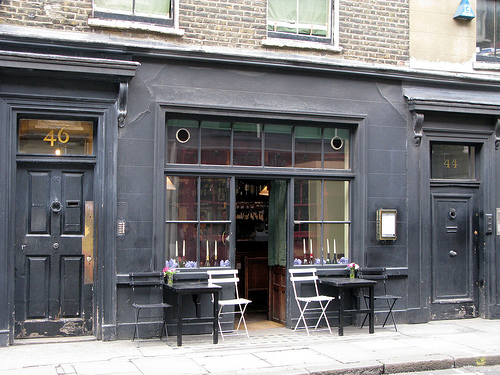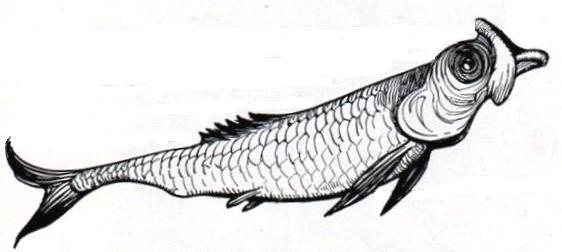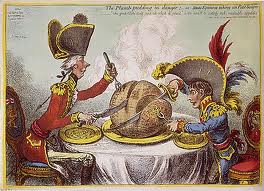Andrew Edmunds in the kitchen & on the page
featuring an Appreciation of the proprietor with a digression on the ancient skin trade.
Our cards are on the table; we like Andrew Edmunds--the restaurant, the shop next door and the man. Taken together, his shard of Lexington Street is one of the most evocative little urban landscapes in London. The two houses that his enterprises occupy date from the long eighteenth century as, for historically paradigmatic purposes, they should.
These observations are prompted by our stumble across an oddly favorable review that appeared some time ago in the London Evening Standard, which unfortunately does not mention the fact, duly noted by FoodandWine.com, that Andrew Edmunds is a restaurant that cooks firmly and creatively in the modern British idiom.

Andrew Edmunds
46 Lexington Street, Soho, London, W1F OLW
020-7487-5708
We have made many visits to the place and by coincidence our notes indicate that we had eaten there shortly after David Sexton, who had reviewed it under the tired pun of “Grape Expectations from Andrew Edmunds.” His thesis: The wine list eclipses the workmanlike food. We do not agree.
The Evening Standard has a proud tradition of food writers, from the peerless Philippa Davenport to Faye Maschler and the personable Lindsey Bareham. Sexton does not let the paper down, even if his prose can induce an occasional wince. He conjures the cozy atmosphere of the narrow little restaurant at Andrew Edmunds:
“The furniture is pretty haphazard. The tables are rickety, the pews a bit hard and the wicker seats of the bar stools are fraying. There’s not much room anywhere, bags and coats get in the way, and you can hardly help but eavesdrop and be eavesdropped on in return.
And the service, though intelligent and friendly, can be pretty direct, the atmosphere being very much that you’re eating with people you know or might know, rather than that you’re the punter and they’re the nameless slavies....
Being an old building, wood-floored and wood-ceilinged, with candles in bottles and paper tablecloths and napkins, it’s naturally romantic. The ambience is Hogarthian, not just Dickensian. But there’s more to it than that. Conversations tend to be intense here--maybe partly because it’s so higgledy-piggledy and hugger-mugger.”
But for the very different food, this is a wonder; the spirit of New Orleans (but that would be LeMoyne or Laveau rather than Hogarth) in London with a touch more reticence, as would be expected; New Orleanians do not just eavesdrop, they join right in.
Sexton goes on to write that the “food is pretty good, though not the main point.” By another coincidence, we have ordered the same things at Andrew Edmonds as he did. Perhaps we have lower standards, because we found the food superior to “pretty good” and more interesting than “straightforward.” Or perhaps not; journalists need hooks when reviewing established restaurants, and Sexton chose the wines as his. The list is good, but not that good; values, yes, if not quite bargains, and as Sexton does note without our negative connotation, too limited in scope to France. He also is right about the delicious fortified wines that the place offers by the glass. Unfortunately there is not much in the way of beer. We are not, however, criticizing the restaurant. In our view, the food outshines everything else that is admittedly appealing about it.
Whenever we have found it on the menu, black pudding with apples has been transcendant at Andrew Edmonds; other good starters include the quail preparations and, as Sexton notes, the pigeon, the scallop with ham and the innovative smoked halibut.

The cod that Sexton describes was perfectly cooked on our visit; it is noteworthy how few restaurants can cook fish competently, let alone perfectly. Cod is delicate; more than a nod at embellishment and the point of the fish would be lost. The salsa verde was not out of place with what amounts to a traditional English accompaniment of broad beans, the London vegetable of the hour, and pureed spinach. As green sauce, salsa verde goes back at least three centuries in English cookbooks and kitchen manuscripts, so why shouldn’t we use the English language to invoke its pedigree? Rebecca Price’s green “Sawce for Fish,” from 1681, would sound startlingly modern if uncooked olive oil were substituted for melted butter:
“Take a quantity of vinegar and a good many anchovies and nutmeg; then take a bunch of herbes, time rosemary, oynion, tye this in a bunch and let it stew in the vinegar and anchovies together, then melt your butter thike, by it self, then put it together just as you poure it upon the fish.” Rebecca Price, The Compleat Cook, ed. Madeleine Masson (1974)
Back in the restaurant, the treatment of our pedigreed lamb was deft, inch-deep slices cooked barely past rare as requested; it had the tender density that lesser lamb lacks. Unlike Sexton, we did not notice an excess of garlic in any of our food.

Gillray, “The plumb pudding in danger”
The shop of the same name next door is no celebrity tie-in selling AE cookware or clothing; between it and the restaurant, we cannot identify the chicken from the egg. Andrew Edmunds is one of the best historical print dealers on the planet, and that is only part of its appeal. There is no website. There is not even a sales setup in the conventional sense, and no apparent accommodation to the twenty-first century. The place is strewn with papers, portfolios and print drawers, cards and framed prints. Sometimes they give away superbly produced little prints and cards as promos, or just as presents; one, a watercolor of Osages and implements, hangs in the Editor’s dining room and holds its own with Blunt charts and a good local nineteenth-century seascape.
There is not, ever, any sales pressure or reluctance by the staff (if you are particularly lucky, Mr. Edmunds will be there) to display or describe the stock, which includes work by Gillray, Rowlandson and other titans. It also can include some astonishing pornographic prints dating as far back as the sixteenth century; they are clever, beautiful, particularly collectible and fetch a premium. The internet steals no jump on the erotic arts from the dawn of the early modern era.
In our experience old porn is hard to find; maybe the market is known only to those informally within an ‘in the know’ network or, at print shops other than Andrew Edmunds, it is off in the back and viewings are by request (that is how museums manage their substantial collections). Perhaps the prudes destroyed a lot of it; there once was a lot around. As Tim Blanning notes of pornography more generally in his superb study of revolutionary Europe, it “must be one of the oldest literary genres, narrowly beaten for first place by religion.” (The Pursuit of Glory, New York 2007, 58)
Back in the salad days, before the value of preindustrial political cartoons raced north and the value of his wage and stock portfolio skidded south together, one of our staffers bought Gillray prints from AE; they, at least, have more than held their value, to say nothing of their abiding appeal on levels both aesthetic and emotional.
Literary Review
As if the food and prints were not enough, the offices of the Literary Review are up a listing stair that careens over Andrew Edmunds the shop. We always smile at the dead or vinously dreggy soldiers lining the steps in commemoration of the blowouts that Auberon Waugh, the Review’s maddening, mourned and missed editor, loved to perpetrate; he once hired an actuary to determine how extravagantly he should consume the contents of his cellar in an effort to leave nothing behind.
It was nice of Waugh’s successor to award John Updike with the first lifetime achievement version of the magazine’s Bad Sex Prize at the end of 2008 just before he died: We are pleased that, as this example of magnanimity demonstrates, the Literary Review has kept its endearing if irritating character under Waugh’s successor, just as the pocket empire of Andrew Edmunds goes its unpretentious and peerless way. Eat in the restaurant, browse in the shop, and bask in the wonder of this ancient and lively corner.

